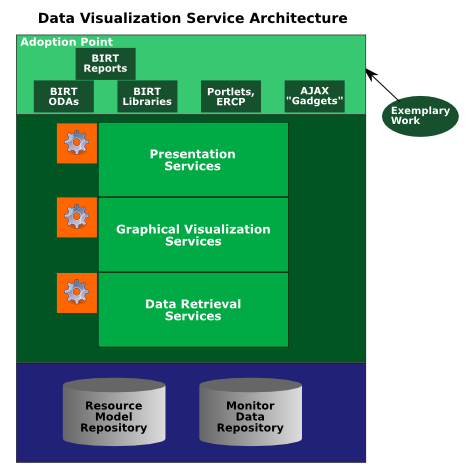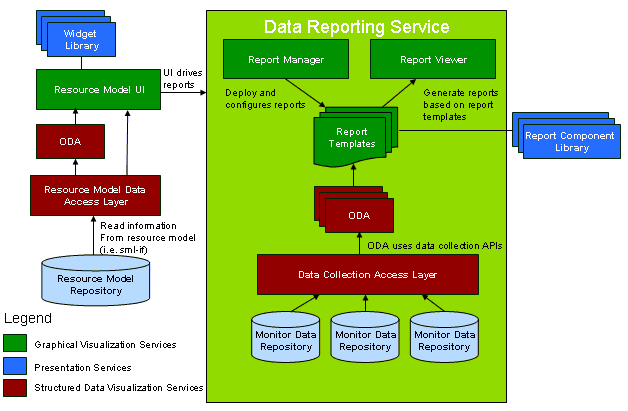Notice: this Wiki will be going read only early in 2024 and edits will no longer be possible. Please see: https://gitlab.eclipse.org/eclipsefdn/helpdesk/-/wikis/Wiki-shutdown-plan for the plan.
CosmosDataReportingComponent
COSMOS Main Page > Architecture >
This article presents the architecture and high-level design of the COSMOS Data Visualization Component.
Contents
COSMOS Data Visualization Overview
The COSMOS Data Visualization framework aims to provide value by building a standards based integration infrastructure that provides access to two dimensions of the COSMOS management architecture, COSMOS Data Collection and COSMOS Resource Modeling. COSMOS Data Visualization provides a well defined set of service interface types that facilitate the exploration of the COSMOS Resource Modeling's repository of models and the retrieval of the COSMOS Data Collection's repository of state, event, and performance information. The model repository is semantically linked to the information in the monitor data repository. This relationship, which is managed in SML through the Resouce Modeling component, is used to connect the exploration of the model with data that has been collected.
The initial focus of the COSMOS Data Visualization framework is on three sets of service interface types:
- The lowest-level service interface types deliver a structured view of the underlying data.
- The second set of service interface types is focused on integrating higher-level visualizations of the retrieved information.
- The third set of service interface types is focused on serving a variety of user interface mechanisms.
The COSMOS Data Visualization framework will provide a comprehensive set of service interface types at each of these three levels of abstraction. Each level offers an adoption point for implementers of management applications. The ![]() icon is intended to designate these adoption points.
icon is intended to designate these adoption points.
The COSMOS Data Visualization framework will also provide examples of implementations of management application components that adopt the service interface types. These are the examples:
- Eclipse BIRT ODAs, Libraries, and Reports that consume the structured data views.
- Eclipse RCP components and JSR-168 Portlets that consume the visualization APIs.
- a set of buzzword-compliant, AJAX-enabled, mashup-ready user interface gadgets that allow for light-weight, browser-based integration of visualization components.
COSMOS Data Visualization and SML
The COSMOS Data Visualization framework will leverage standards implemented by COSMOS Data Collection and COSMOS Resource Modeling. The domain-specific capabilities expressed in the SML-IF resource models will be used by COSMOS Data Visualization in the assembly of componentry for exploration, visualization, and interaction with the modeled entities.
THE FOLLOWING PARAGRAPH IS EXTINCT and will be replaced soon (Cthomas.groundworkopensource.com 20:42, 5 March 2007 (EST)): The SML-IF resource models will be used to associate COSMOS Data Reporting interfaces with COSMOS Data Collection interfaces for purposes of reporting, visualization, and interaction. The SML-IF resource models will also be used to associate COSMOS Data Visualization interfaces with the COSMOS Management Enablement interfaces for the purposes of reporting, visualization, and interaction.
COSMOS Data Visualization and other Open Standards
needs more work -- cthomas 27-feb-2007
- structured data access interface types: WSDL for web services
- portlet interface types: JSR-168
- web browser interface types: n/a
COSMOS Data Visualization Component Design
Service Interface Types
The services of the COSMOS Data Visualization Component are organized into sets of interface types, organized as adoption points for implementers of management applications. The service interface types are grouped according to the degree of abstraction they provide:
- Service Interface Types for Structured Data Visualization
- Service Interface Types for Graphical Visualization
- Service Interface Types for Browser-based Visualization
The following diagram illustrates the high level interaction between the data visualization components.
Each of these sets of service interface types is explored further in the following sections.
Service Interface Types for Structured Data Visualization
This set of service interface types is organized for adoption by management application components that consume structured data, for example, tabular displays of information about modeled resources, status information, events, and performance data.
Open Data Access (ODA) components will be constructed to utilize resource model componentry to access the resource model repository. Similarly ODAs will be created to utilize the data collection componentry to acces the data collection repository. With ODAs in place BIRT report templates can be created to provide customized views of the data.
itemize service interface types for structured data access here...
Service Interface Types for Graphical Visualization
This set of service interface types is organized for adoption by management application components that consume user interface visualizations, for example, portlet-based displays of information describing modeled resources, status information, events, and performance data. This set of service interface types will also serve the Eclipse workbench.
itemize service interface types for visualization here...
Service Interface Types for Browser-based Visualization
This set of service interface types is organized for adoption by management application components that consume user interface visualizations, for example, browser-based gadgets (obviously, we need to choose an AJAX-enabled quasi-standard pattern to implement!) that can be composed into mashups.
itemize service interface types for light-weight browser-based components here...


